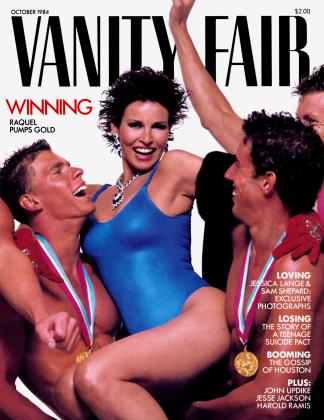Sign In to Your Account
Subscribers have complete access to the archive.
Sign In Not a Subscriber?Join NowA POWERFUL DRAGONFLY
V.S. PRITCHETT contemplates Chagall's "two-faced bride" and sees a little orgy of color swirling around the raspberry nipple
At first glance Chagall's La Mariee a Double Face—the doublefaced bride—seems to have come out of one of Chekhov's comic but songlike stories. If she had been less bony, the shrewd lady in "A Happy Ending," whose profession was "matchmaking and many other matters of which it is usual to speak only in whispers," would fit the occasion. (That lady found herself being bowled over by a money-minded railway guard on his day off.) The picture is indeed alive with whispers. Or the painting might spring from one of Maupassant's cynical pieces of the before-and-after kind: the naive young bride under the veil has not foreseen the aging woman she will become. Notice that both faces have their mouths open—the young one shyly breathless; the older might be shouting the "Hi, everybody!" of a dreadful liberation. We are quite wrong. The bride is not yet a wife; there is no ring on the older woman's hand. Notice again that down in the right-hand comer there is the tiny figure of a silent, very sedate young woman, perhaps a niece, muttering, "Aunt! You've gone out of your mind. Behave yourself."
Of course, the picture is one of Chagall's candid fantasies. The shouting lady is daydreaming. She is not on this earth—no feet—she has taken to the sky, the blue night sky. The sight of the new moon has carried her away. She has probably seen that moon and—as country magic requires—she has probably bowed three times, spat three times, and turned her money over. And don't overlook the violet halo above her two-faced head: that halo is not saintly. It has the darkness of primitive magic and poison. And why not? May the lady not be a fortune-telling Russian gypsy who has come into her own? Indeed, we see a tiny white horse hundreds of feet below her on the earth. There is a tiny dancing dog and a little street band. Look at the mature face again as she takes to the air: she does not care anymore about the line on her long neck, her long prying nose curving out far beyond her chin. She is confident, her arms are akimbo: she knows how to carry and open a fan and how to snatch at a pot of flowers which will pass as a bouquet, and doesn't mind if her large ringless hands have the earth still on them. The gypsy has just ripped those flowers from someone's garden at the last minute.
Still—she can't be a gypsy. Look at her bodice and her dress. They are not gaudy. They are delicate in color. The bodice and its long blue frill are pretty; no gypsy would wear a dress so low and show a curiously young small breast and a nipple as enticing as a raspberry, even if we suppose she is carelessly dancing as she floats. She is wanton. Experience has told her that the hidden skin of the body keeps its youth much longer than the face exposed to weather and time. Chagall knows the two-faced "bride" has a single, tender-skinned body.
At this point we are breathless: we start thinking about Art. The picture is at once a witty cartoon and a little orgy of color. What a powerful dragonfly changes the tale! If Hogarth had caught this sight in his careful, moralizing, eighteenth-century way, he would be preaching the triumph of Experience over Innocence. If Goya had tackled it, Innocence would be warm, shapely, without doubts, safe in its grace until the very instant when Experience showed its leer. Hogarth would teach a lesson: You have a choice. Are you the good Industrious Apprentice conforming to the morality of the new middle class? He will show you what will happen if you become a gambling, wenching Rake. Terror will spring out at the Virtuous. Times are corrupt and dangerous.
But Chagall? He has no lesson. As we know, he is a man for the miming and fantasy of the circus, where the show cavorts, the little dog dances, the white horse trots, and the toy band plays. He has himself come on to clown in silent grimaces the roles of the two-faced woman. He has stuck a mask on the back of the aging but vigorous and reckless woman's head. Look at her swaying body, her strong working hands, that dark, determined marketing eye, the frank willingness of the open mouth. "Good luck to her on her fling!" we shout, even if it is all a dream. A woman like that will match it. She is not going to waste the huge bunch of flowers she has snatched. She is all woman, even if she is only a circus turn. And it is. Look again at what we thought was a violet halo over her head. Isn't it in fact the hole at the top of the circus tent? Isn't that the dark royalblueness of the night air outside, the enveloping blue of the night fancies that will come to us as we leave the tent thinking of that nipple?
 View Full Issue
View Full Issue












Subscribers have complete access to the archive.
Sign In Not a Subscriber?Join Now